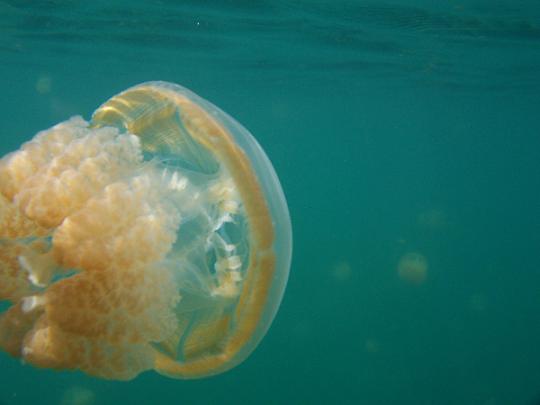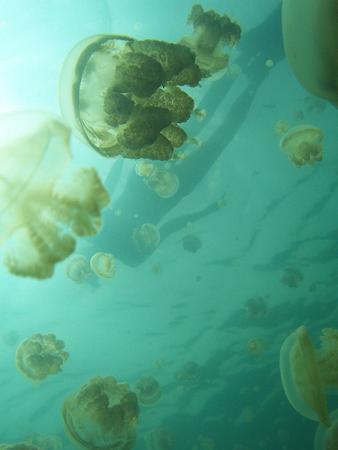
 |
 |
 |
 |
 |
| Home Page | Featured Articles | Awards | Photo Gallery | About Yvonne |
It’s so tempting to put out a finger and poke a jelly. Pastel-colored transparent globes float ethereally past in a slow, pulsating rhythm. No eye returns your gaze; no legs or arms give it motion, only a soft, squishy-looking body tempts you to touch, just a little caress. . . .
* * * *
It’s a fantasy imagined by anyone who spies the tantalizing jelly. (Naturalists prefer to call these invertebrates “jellies” instead of “jellyfish” since they are not fish.)
But ask any swimmer who’s inadvertently brushed up against its tentacles and you get a resounding “No way!” in reply.
Jellies float innocuously, trailing stringy, almost transparent tentacles many times longer than their bodies. These tentacles are filled with nematocysts, stinging cells that paralyze unwary sea creatures that then become the jelly’s meal.
A swimmer who wanders too near a jelly’s tentacles will, if lucky, feel only a stinging sensation and emerge with welts that burn for a few days then disappear. Some jelly stings, however, can be crippling or even fatal to humans.
Naturally, swimmers and snorkelers admire the colorful creatures from a respectful distance.
But suppose you were invited to swim with non-stinging jellies. Would you say “yes”?
It’s a short motorboat ride to Mecherchar, one of the many islands that make up the Palau archipelago.
“There are other islands also with jellyfish lakes, but this is the most accessible,” says Daniel, your Palauan guide, as he and Davis the boat driver ease alongside the small wooden dock and secure the lines.
“We have to hike for about 10 minutes uphill on rocks, so wear good shoes or sandals. And don’t forget your mask, snorkel, fins and camera.”
You slather on a quick glob of sunblock, grab your cap and follow Daniel and the other explorers through the dense jungle to a narrow trail that rises almost straight up.
“Warning! Use the handrail. Do not touch this tree. It is toxic!”
A hand-lettered sign nailed to a wooden handrail alerts the unwary not to grab onto the trunk of a nearby tree for support. “And don’t stand under the tree, either,” warns Daniel. “If the sap drips on you, it’ll burn your skin.”
Tall vegetation shades you from the late morning sun as you clamber up the stair-like, rocky, mud-covered trail over the hill, then down the other side. In a few minutes, you’re standing on the mangrove-lined shore of Jellyfish Lake, one of the sites of the CBS TV series, “Survivor: Palau.”
Jellyfish Lake is about the size of two Olympic swimming pools. A sign on the small wooden dock tells how the mastigias species of jelly arrived here.

As you adjust your mask, snorkel and fins, Daniel gives the group instructions. “Jellies follow the sun, so we’ll swim to the far end of the lake where they’re concentrated right now. If you were to come back this afternoon, you’d find them in a different area of the lake because that’s where the sun would be. Swim gently. Fast arm or leg movements or hard fin kicks will hurt them. And don’t lift them out of the water. OK, pool’s open!” and he dives in.
You fasten your underwater camera on your wrist and jump into water as warm as a bathtub. “It’s salty, too” says one swimmer, grimacing as he adjusts his snorkel.
“Yes,” replies Daniel. “A marine lake is saline but not as salty as the ocean. This lake actually has three distinct layers of water, each saltier than the one above it. The bottom layer at about 100 feet is so salty and full of sulfides that it’s toxic. No life grows there, at least any that we know of.”
You swim halfway across the lake when suddenly you hear a squeal. It’s from the swimmer ahead of you! You stop and peek through your mask.

A half dozen small pale orange blobs the size of large navel oranges float in front of you, suspended in the jade-green water. You slow down your strokes and glide into more and more blobs.
These are the jellies - and they don’t have tentacles!
You put out a tentative hand and one floats across your palm. It’s soft and silky. It doesn’t try to swim away and you don’t try to corral it. Slowly and carefully, you glide forward into the center of the “herd.”
Hundreds and hundreds of gelatinous blobs surround you, caressing your bare arms and legs like a living bubble bath.
One jelly about the size of a cantaloupe swims a few inches from your mask. To swim, it turns itself nearly inside out, squeezes itself and undulates gracefully forward.
You can’t help but reach for it.
A cautious finger encounters its tripe-like, eight-sectioned underside before it pulses away, seemingly unaware of your touch. You can’t believe it; you’ve just interacted with an invertebrate species! You turn to look at the other swimmers as they gently fondle the little creatures and wonder, what do jellies think of human contact - if they think. . . .
You continue your slow-motion swim. The water’s so warm and the jellies so thick, it makes you think you’re swimming in Jell-O ™ - or maybe jellyfish soup! The thought makes you laugh out loud - and you nearly spit out your snorkel!
Geologists believe that during the last Ice Age, Mecherchar and other nearby islands in the Palauan archipelago underwent upheavals that created marine lakes and isolated the mastigias jelly and another species, the moon jelly.
Lacking all but one predator, an anemone that feeds on jelly young, the jellies eventually lost their need to sting to protect themselves. Their tentacles with stinging nematocysts disappeared.
To eat, the jellies photosynthesize with zooxanthellae, the algae between their inner and outer layers. In other words, sunlight makes their food. Jellies concentrate themselves where the sun’s rays are the strongest and float usually no more than ten feet deep during a sunny day.
Before the CBS TV series, only die-hard scuba divers, World War II history buffs and travel agents had heard of the Republic of Palau, an archipelago (collection of islands) located just north of Australia, southwest of the US Territory of Guam, about seven degrees north of the equator in the western Pacific Ocean.
Figure a 20-hour plane ride from the US to Koror, Palau’s biggest city. Sightseeing boats leave from Koror’s docks on camping, birding, hiking, kayaking, fishing, diving, and snorkeling excursions to Palau’s many islands. The smaller ones, such as the one used for location shooting in “Survivor: Palau” are giant boulders covered with vegetation. From a boat, these islands resemble giant Chia Heads ™.
English and Palauan are the official languages and the American dollar is the official currency.
For more info, consult Lonely Planet’s Diving and Snorkeling Palau, www.visit-palau.com, or your favorite travel agent.
c. “Follow Me!” Alamogordo (NM) Daily News 2005
